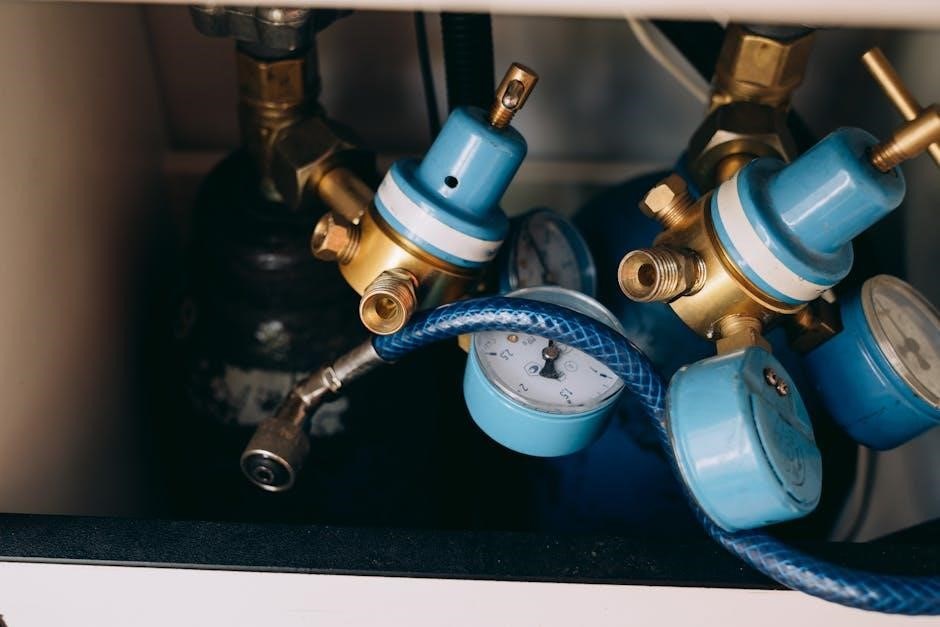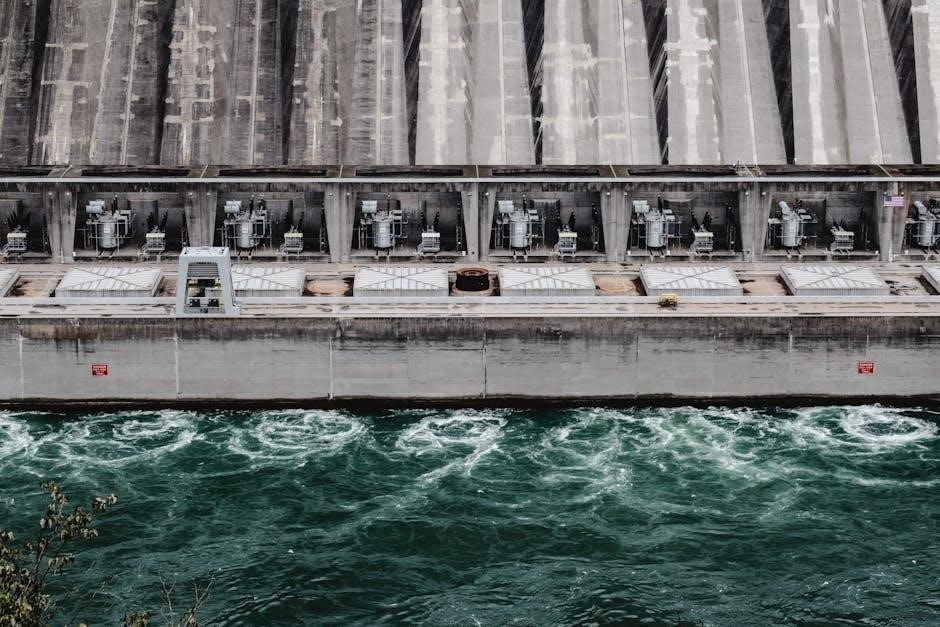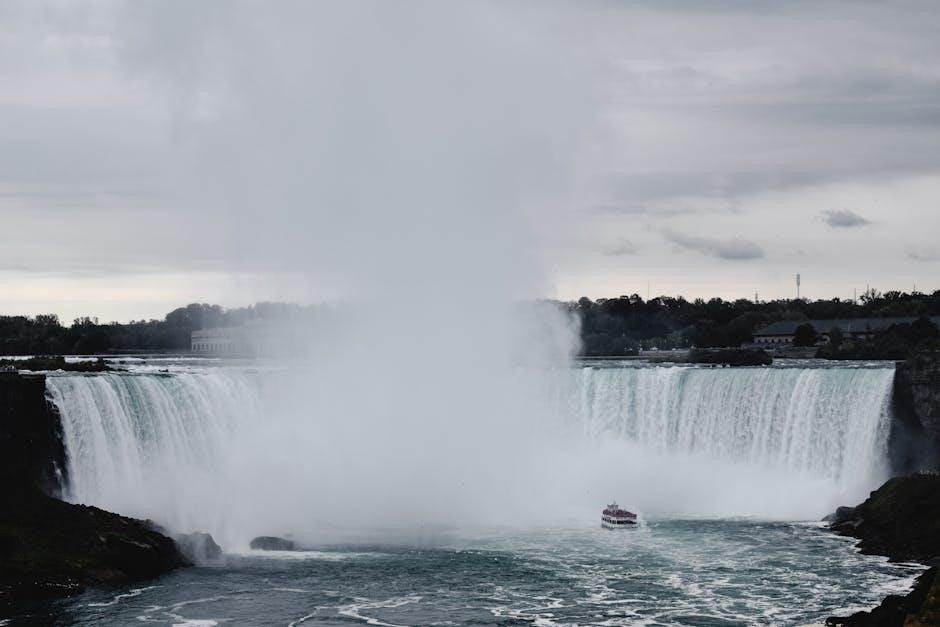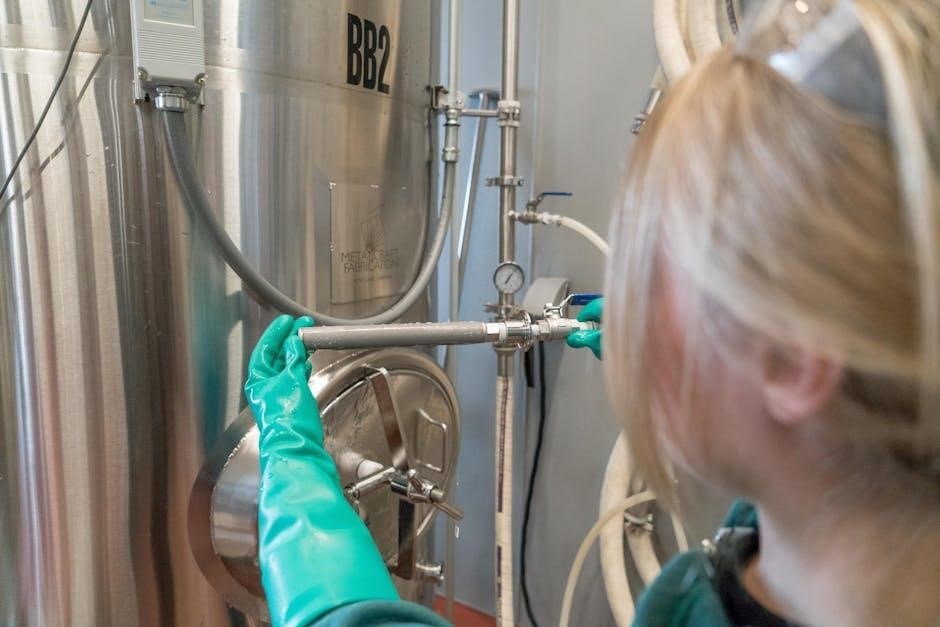
Hydraulic fittings are essential connectors in fluid power systems, ensuring reliable transfer of hydraulic fluids. Available in various types like JIC, SAE, and NPT, they are crafted from durable materials such as stainless steel and brass, designed for high-pressure applications and long service life. Leading manufacturers like Parker Hannifin and Gates offer innovative solutions, making them indispensable in industries requiring precise fluid control and durability.

Types of Hydraulic Fittings
Hydraulic fittings come in various types, including JIC, SAE, NPT, BSPP, and ORFS. Each offers unique connection methods commonly suited for different hydraulic system requirements.
2.1. JIC Fittings
JIC (Joint Industrial Council) fittings are a popular choice for hydraulic systems, known for their durability and versatility. They are commonly used in high-pressure applications, such as aerospace, construction, and heavy machinery. JIC fittings feature a flare-type connection, ensuring a secure and leak-resistant seal. Their design allows for easy installation and adaptability to various system configurations. Often used with hydraulic hoses, JIC fittings are ideal for applications requiring flexibility and resistance to vibration. They are widely recognized for their compatibility with international standards and are preferred by manufacturers like Parker Hannifin and Manuli Hydraulics. Available in a range of sizes and configurations, JIC fittings are a reliable solution for demanding hydraulic environments.
2.2. SAE Fittings
SAE (Society of Automotive Engineers) fittings are widely used in hydraulic systems for their reliability and performance. These fittings are designed to meet stringent standards and are ideal for high-pressure applications. SAE fittings typically feature a flare or O-ring seal, ensuring a leak-free connection. They are commonly used in automotive, industrial, and heavy-duty equipment. Available in various sizes, SAE fittings are compatible with a range of hydraulic hoses and tubing. Their durability and resistance to corrosion make them a popular choice for harsh environments. SAE fittings are also known for their ease of installation and adaptability to different system requirements. They are often preferred in applications where high flow rates and pressure resistance are critical. With sizes ranging from 1/4″ to 2″, SAE fittings are versatile and widely accepted across industries. Their compatibility with international standards ensures their reliability and performance in diverse hydraulic systems.

2.3. NPT Fittings
NPT (National Pipe Taper) fittings are widely recognized for their tapered threads, which create a tight, leak-free connection when properly installed. These fittings are commonly used in hydraulic and pneumatic systems where a reliable seal is essential. NPT fittings are popular in industries such as oil and gas, industrial manufacturing, and construction due to their durability and performance under high-pressure conditions. They are available in various materials, including carbon steel, stainless steel, and brass, each offering unique benefits like corrosion resistance or strength. NPT fittings come in a range of sizes to accommodate different applications, from small-diameter tubing to large-scale pipelines. Proper installation is crucial, as the tapered threads require precise alignment and torque to ensure a secure seal. Their compatibility with a variety of connectors and adapters makes them a versatile choice for hydraulic systems. NPT fittings are a reliable option for applications requiring a consistent and durable connection.
2.4. BSPP Fittings
BSPP (British Standard Pipe Parallel) fittings are a popular choice in hydraulic systems, particularly in European industries. These fittings feature parallel threads and are known for their reliability in high-pressure applications. BSPP fittings are widely used in industries such as agriculture, construction, and manufacturing, where durable and leak-free connections are critical. They are available in a variety of materials, including stainless steel, carbon steel, and brass, making them suitable for diverse operating conditions. The parallel thread design ensures a secure and even connection, reducing the risk of leakage. BSPP fittings are often used in conjunction with adapters and connectors to accommodate different system requirements. Their versatility and compatibility with international standards make them a preferred option for hydraulic systems requiring precision and strength. BSPP fittings are also known for their resistance to corrosion and ability to withstand harsh environmental conditions, ensuring long-term performance and reliability.
2.5. ORFS Fittings
ORFS (O-Ring Face Seal) fittings are a modern and versatile option in hydraulic systems, known for their superior sealing capabilities. These fittings utilize an O-ring and a straight thread design, providing a leak-free connection even in high-pressure and high-temperature environments. ORFS fittings are widely used in industries such as aerospace, automotive, and heavy machinery, where reliability and durability are paramount. The O-ring ensures a tight seal, while the straight thread design allows for easy assembly and disassembly. ORFS fittings are compatible with a variety of materials, including stainless steel, carbon steel, and brass, making them suitable for diverse applications. Their compact design and resistance to vibration make them ideal for space-restricted systems. Additionally, ORFS fittings are reusable, reducing maintenance costs over time. Their ability to handle harsh operating conditions and provide consistent performance has made them a preferred choice in many hydraulic systems worldwide.

Materials Used in Hydraulic Fittings
Hydraulic fittings are crafted from durable materials like stainless steel, brass, and carbon steel, ensuring resistance to corrosion, high pressure, and extreme temperatures, suited for various industrial applications.
3.1. Stainless Steel
Stainless steel is a highly durable and corrosion-resistant material widely used in hydraulic fittings. Its excellent mechanical properties, such as high strength and resistance to extreme temperatures, make it ideal for demanding applications. Commonly used in marine and chemical environments, stainless steel fittings are less prone to degradation from harsh chemicals or moisture. They are also resistant to pitting and crevice corrosion, ensuring longevity in challenging conditions. Stainless steel fittings are often used in high-pressure hydraulic systems, offering reliability and performance. Popular grades like 304 and 316 stainless steel are preferred for their superior corrosion resistance. These fittings are manufactured through precise machining and forging processes to ensure dimensional accuracy and durability. Stainless steel’s ability to withstand aggressive media and maintain integrity under stress makes it a top choice for critical hydraulic systems. Its low maintenance and long service life further enhance its appeal in industrial applications.
3.2. Brass
Brass is a versatile and cost-effective material commonly used in hydraulic fittings, offering a balance of durability and corrosion resistance. It is an alloy of copper and zinc, known for its excellent machinability and high tensile strength. Brass fittings are widely used in low to medium pressure hydraulic systems, where their resistance to wear and tear is advantageous. They are particularly suitable for applications involving water, oil, and gas due to their ability to withstand moderate corrosion. Brass is also non-magnetic and exhibits good electrical conductivity, making it a preferred choice for specific industrial and marine applications. However, brass fittings are less suitable for high-temperature or high-pressure environments compared to stainless steel. Despite this, their affordability and reliable performance make them a popular option for many hydraulic systems. Brass fittings are often manufactured using precision machining techniques to ensure tight tolerances and leak-free connections.

Leading Manufacturers of Hydraulic Fittings
Prominent manufacturers like Parker Hannifin, Gates, and Manuli Hydraulics dominate the hydraulic fittings market, delivering high-quality, innovative solutions for diverse industrial applications worldwide.
4.1. Parker Hannifin
Parker Hannifin is a global leader in hydraulic fittings and systems, renowned for its innovative solutions and high-quality products. The company specializes in hydraulic and motion control technologies, offering a wide range of fittings, including adapters, connectors, and couplers. Parker Hannifin’s products are designed to meet the demands of various industries, ensuring durability and reliability in high-pressure applications. With a strong commitment to research and development, the company consistently delivers cutting-edge hydraulic fittings that adhere to international standards. Its global presence and extensive distribution network make it a preferred choice for professionals seeking superior performance and longevity in hydraulic systems. Parker Hannifin’s dedication to excellence has solidified its position as a trusted name in the hydraulic fittings industry.
4.2. Gates
Gates Corporation is a prominent global manufacturer of hydraulic fittings and related components, known for its high-quality products and innovative solutions. The company offers a wide range of hydraulic hoses, fittings, and adapters designed to meet the demands of various industrial applications. Gates is particularly recognized for its durability and reliability, ensuring optimal performance in challenging environments. Their hydraulic fittings are widely used in industries such as agriculture, construction, and heavy machinery. The company emphasizes precision engineering and advanced materials to deliver superior products. Gates also prioritizes research and development to stay ahead in the market, providing cutting-edge solutions for hydraulic systems. With a strong global presence, Gates continues to be a trusted name in the hydraulic fittings industry, offering products that are both efficient and long-lasting. Their commitment to excellence ensures consistent quality and customer satisfaction.
4.3. Manuli Hydraulics
Manuli Hydraulics is a globally recognized leader in the design, production, and distribution of high-quality hydraulic fittings and components. With a strong focus on innovation and sustainability, the company serves a wide range of industries, including agriculture, construction, and heavy machinery. Manuli Hydraulics specializes in hydraulic hoses, fittings, and adapters that meet the highest international standards. Their products are known for their durability, reliability, and performance in demanding environments. The company emphasizes research and development to create advanced solutions for hydraulic systems. Manuli Hydraulics also prioritizes customer satisfaction by offering tailored solutions and exceptional service. Their extensive product portfolio includes a variety of fitting types, ensuring compatibility with diverse applications. By adhering to strict quality control measures, Manuli Hydraulics maintains its reputation as a trusted partner in the hydraulic fittings industry, delivering products that enhance efficiency and productivity worldwide.

Applications of Hydraulic Fittings
Hydraulic fittings are essential in various industrial and mobile systems, including heavy machinery, construction equipment, and fluid power systems, ensuring reliable fluid transmission and system performance.
5.1. High-Pressure Hydraulic Lines
Hydraulic fittings are critical in high-pressure hydraulic lines, commonly used in industrial machinery, oil and gas systems, and heavy-duty vehicles. These fittings ensure secure connections in systems operating at elevated pressures, often exceeding 3,000 PSI. Designed with precision, they prevent fluid leakage and maintain system integrity under extreme conditions. High-pressure hydraulic lines rely on fittings like JIC, SAE, and ORFS, which are engineered for durability and reliability. These components are essential for transferring hydraulic fluid efficiently, enabling machinery to perform tasks requiring significant force and precision. In applications such as excavators, cranes, and injection molding machines, high-pressure hydraulic lines and their fittings are indispensable. The materials used, such as stainless steel and high-tensile brass, are selected for their strength and resistance to corrosion, ensuring long-term performance in demanding environments. Proper installation and maintenance of these fittings are crucial to avoid system failure and ensure operational safety.
5.2. Fuel and Oil Transfer
Hydraulic fittings play a vital role in fuel and oil transfer systems, ensuring secure and leak-free connections. These systems are critical in industries such as petroleum refining, marine, and aerospace, where the efficient transfer of fluids is essential. Hydraulic fittings like NPT, BSPP, and SAE are commonly used for their compatibility with high-flow rates and varying pressure conditions. Stainless steel and brass fittings are preferred due to their resistance to corrosion and durability in harsh environments. Properly installed fittings minimize the risk of contamination and spills, which is crucial for maintaining environmental and operational safety. Regular maintenance, including inspections and tightening, ensures the longevity of these systems. Hydraulic fittings in fuel and oil transfer applications must meet strict industry standards to handle hazardous materials safely and efficiently. Their reliability is paramount to prevent downtime and ensure smooth operations in demanding industrial settings.

5.3. Lubricants and Antifreeze Solutions
Hydraulic fittings are essential in systems involving lubricants and antifreeze solutions, where leak-free connections are critical to prevent contamination and ensure efficient fluid flow. These systems are widely used in automotive, industrial machinery, and HVAC applications to maintain optimal operating temperatures and reduce wear on moving parts. Fittings such as JIC, NPT, and ORFS are commonly employed due to their reliability and adaptability. Stainless steel and brass fittings are preferred for their resistance to corrosion, which is vital when handling antifreeze and lubricating oils. Proper installation and sealing ensure that these fluids are distributed evenly, preventing overheating and mechanical failure. Regular maintenance of hydraulic fittings in these systems is crucial to avoid downtime and extend equipment lifespan. The use of high-quality fittings ensures the integrity of lubricants and antifreeze solutions, making them indispensable in modern industrial and automotive applications.
5;4. Air and Water Systems
Hydraulic fittings play a vital role in air and water systems, ensuring secure connections and efficient flow. These systems rely on fittings like NPT, BSPP, and push-in connectors to maintain pressure and prevent leaks. In pneumatic applications, such as air compressors and pneumatic controls, fittings must withstand varying pressures while ensuring minimal airflow restriction. Similarly, in water systems, including irrigation and water treatment plants, hydraulic fittings are used to connect pipes and valves, ensuring durability and resistance to corrosion. Stainless steel and brass fittings are commonly used in these applications due to their resistance to rust and chemical degradation. Proper installation and maintenance of these fittings are crucial to prevent contamination and ensure system reliability. Their versatility and strength make them indispensable in both industrial and residential air and water systems, contributing to overall system efficiency and longevity. Regular inspection is recommended to avoid potential failures and maintain optimal performance.

Standards and Specifications for Hydraulic Fittings
Hydraulic fittings must meet strict ISO and SAE standards, ensuring compatibility, safety, and efficiency in hydraulic systems. These specifications prevent leaks and ensure reliable connections.
6.1. ISO Series Fittings
ISO series fittings are designed to meet international standards for hydraulic systems, ensuring global compatibility and reliability. These fittings are typically used in high-pressure applications and are known for their robust design. They are manufactured from materials like stainless steel, carbon steel, and brass, offering excellent durability and resistance to corrosion. ISO series fittings are commonly used in industrial machinery, construction equipment, and automotive systems. Their sizes and pressure ratings are standardized, making them easy to integrate into existing systems. These fittings are also popular for their ability to handle harsh operating conditions, including extreme temperatures and vibrations. ISO series fittings are widely recognized for their performance and are often specified in hydraulic systems requiring precise connections and long service life.
6.2. SAE Standards
SAE (Society of Automotive Engineers) standards are widely adopted in the design and manufacturing of hydraulic fittings, ensuring consistency and performance across various applications. These standards specify dimensions, materials, and testing requirements for fittings to guarantee compatibility and reliability. SAE standards cover a range of fitting types, including flared, O-ring, and push-to-connect designs. They are particularly important in automotive and industrial hydraulic systems, where high pressure and precision are critical. SAE standards also address factors like temperature range, pressure ratings, and corrosion resistance, ensuring fittings meet rigorous safety and durability criteria. Compliance with SAE standards is essential for hydraulic systems to function efficiently and safely, making them a cornerstone of modern hydraulic engineering and design.

Installation and Maintenance of Hydraulic Fittings
Proper installation ensures leak-free connections, while regular maintenance prevents contamination and wear. Cleaning, alignment, and torque specifications are critical for optimal performance and longevity of hydraulic systems.
7.1. Crimping and Assembly
Crimping and assembly are critical steps in installing hydraulic fittings, ensuring secure and leak-free connections. Hydraulic hoses are attached to fittings using specialized crimping tools or machines, which compress the fitting onto the hose, creating a permanent bond. Proper alignment and preparation of the hose and fitting are essential to avoid damage or improper sealing. The crimper must be calibrated to the correct specifications for the hose and fitting size to ensure a reliable connection. Post-crimping inspection is recommended to verify the integrity of the assembly. Improper crimping can lead to system failure, making adherence to manufacturer guidelines crucial. Regular maintenance, such as checking for wear or damage, is also vital to uphold hydraulic system performance and safety. Correct crimping techniques ensure optimal functionality and longevity of hydraulic components in demanding applications.
7.2. Tightening Torques
Tightening torques are essential for ensuring the integrity and safety of hydraulic fittings. Proper torque values, specified by manufacturers, must be followed to avoid under-tightening, which can lead to leaks, or over-tightening, which may damage threads or fittings. Hydraulic systems operate under high pressure, making precise torque application critical to prevent failure. Torque wrenches or impact wrenches calibrated to the recommended specifications are typically used for this process. It is important to refer to the manufacturer’s guidelines for specific torque values, as they vary depending on fitting types, sizes, and materials. Regular checks of tightened connections are advisable to maintain system reliability. Improper torque application can compromise the entire hydraulic system, leading to downtime and safety hazards. Always use appropriate tools and follow best practices to ensure secure and reliable connections in hydraulic applications. Adhering to torque specifications is a fundamental aspect of hydraulic fitting installation and maintenance.
7.3. Inspection and Replacement
Regular inspection of hydraulic fittings is crucial to identify wear, damage, or leaks, ensuring system reliability and safety. Visual checks should be performed to detect signs of corrosion, thread damage, or deformation. Hydraulic hoses and fittings should also be inspected for abrasion, cracks, or softening of materials. If any damage is found, immediate replacement is necessary to prevent system failure. Replacement procedures must adhere to manufacturer guidelines to ensure compatibility and proper installation. Old or faulty fittings should be discarded and replaced with new ones that meet the required specifications. Proper tools and techniques are essential during replacement to avoid further damage. Regular maintenance schedules should include inspection and replacement protocols to maintain hydraulic system performance and prevent unexpected downtime. Always prioritize safety by following recommended practices and using high-quality components. Timely inspection and replacement are vital for the longevity and efficiency of hydraulic systems.

Hydraulic Hose Fittings Charts and Guides
Hydraulic hose fittings charts and guides provide essential information for proper system design and maintenance. They detail size specifications, material compatibility, and pressure ratings, ensuring optimal performance and safety.
8.1. Size Charts
Size charts for hydraulic hose fittings are critical tools for ensuring proper system design and functionality. These charts provide detailed measurements, including inner diameters, thread sizes, and overall lengths, helping users select the correct fitting for their application. By referencing these charts, technicians can verify compatibility between hoses and fittings, preventing issues like leaks or system failure. They often include tables or diagrams that list standard sizes, such as dash sizes and thread types, making it easier to identify the right component. Proper use of size charts ensures that hydraulic systems operate efficiently and safely, adhering to manufacturer specifications and industry standards. Regular consultation of these charts is essential for maintaining optimal performance and avoiding costly repairs.
8.2. Material Compatibility
Material compatibility is a critical factor in selecting hydraulic fittings to ensure they can withstand the intended application’s conditions. Different materials react differently to various fluids, temperatures, and pressures, making compatibility essential for system reliability. For example, stainless steel fittings are ideal for corrosive environments, while brass is suitable for applications involving oils and fuels. Compatibility charts are often provided in hydraulic fittings guides to help users match materials with specific fluids and operating conditions. These charts detail chemical resistance, temperature limits, and pressure ratings, ensuring safe and efficient system performance. Proper material selection prevents premature wear, corrosion, and leakage, which can lead to costly repairs and downtime. Always consult manufacturer guidelines and compatibility charts to ensure the chosen fittings meet the application’s demands and industry standards. This step is vital for maintaining system integrity and operational safety.